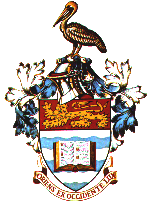





Assignment
of Mutants Genes to Linkage Groups
Cy/Pm; Di/Sb Stock in Drosophila
Assignment
of mutant genes to linkage groups
(see lab # 2 in lab manual)
It is relatively easy to determine the chromosome on which a mutation
is located using the balanced marker stock Curly/Plum
(2); Dichaete/Stubble (3). This stock is perpetually heterozygous
for the four dominant mutant genes Cy, Pm,
D and Sb
which are lethal when homozygous. Cy (Curly wing) and Pm
(Plum eye colour) are located on chromosome 2, while D (Dichaete
wing - affects wing shape) and Sb (Stubble bristles) are third chromosome
mutants.
No crossing over will occur between Cy and Pm, nor between
D
and Sb because these genes are associated with chromosome inversions.
Cy/Pm D/Sb is a balanced lethal stock; the flies breed true
when crossed among themselves. All flies of this strain are therefore heterozygous
at these loci.
Fig: Intercross of Cy/Pm;
D/Sb
Note:
1. There are 4 linkage groups in Drosophila
2. There is no recombination by crossing-over in male Drosophila
3. Chromosome pair I are sex chromosomes, the female is homogametic
(XX) and the male is heterogametic (XY).
Method
1. Mate a female homozygous for the mutation in question (m/m)
to a male of the marker strain (Cy/Pm; D/Sb).
Results
a. If all the F1 flies show the mutation, it is a dominant
mutation (go to step 2).
b. If all F1 males and no F1 females show the
mutation, it is a sex-linked recessive mutation.
c. Otherwise, it is an autosomal recessive mutation.
2. For a dominant mutation, mate wild-type females with F1
males of one of the following four phenotypes: Cy;D, Cy;Sb,
Pm;D
or Pm;Sb. For this mating, choose the phenotype that least interferes
with the expression of the mutation.
Results
a. If all females show the mutation, it is sex-linked dominant (only
females inherit the paternal X-chromosome).
Fig: Cross of
Female
x Male
M + + +/+ x + Cy + D +
Pm + Sb
b. If no F2 Curly or Plum progeny carry the
mutation, it is a chromosome 2 dominant. Similarly, if you had chosen the
Cy/M
Sb/+ male, there would be no Cy/M progeny; or if you had used
Pm/M males there would be no Pm/M progeny. The mutation segregates
from chromosome 2 markers during meiosis, hence chromosome 2 markers and
the mutation will not be found together in the F2.
Fig
c. If no F2 Dichaete or Stubble progeny carry
the mutation, then it is a chromosome 3 mutation.
Fig
d. Equal association of M with Cy and D indicate
that M is located on the 4th chromosome, i.e. M is
assorting independently with both chromosome 2 and 3 mutations.
3. Autosomal recessive mutation
Mate females of the mutant strain (m/m) with F1 males
of one of the four phenotypes produced in step 1: Cy;D, Cy;Sb,
Pm;D
or Pm;Sb (backcross). Choose the phenotype that least interferes
with scoring the mutation of unknown linkage group.
Results
a. None of the Curly or Plum F2 carry the
mutation, indicating that the mutation is on chromosome 2.
Because of the absence of crossing over in male Drosophila, the
m
gene carried by the F1 males cannot cross over to the
Cy
(and Sb) chromosome(s). This if m is located on the 2nd chromosome
homologue of Cy, its wild-type (dominant) allele is located on the
Cy chromosome and the F1can form only Cy
or m gametes for this chromosome. Fertilisation of female m
eggs will never produce Cy flies that are also
m in phenotype.
Since the third chromosome assorts independently of the second, half the
m gametes (male) will be m Sb and half will be m +Sb,
hence fertilisation of m + eggs produces m/m Sb/+ and m/m
+/+.
Fig
b. m does not appear with Dichaete or Stubble,
hence m is on chromosome 3. Similar reasoning to (a) above.
c. if m appears equally with both Cy and Sb in
the F2, then m is on chromosome 4.
For more genetics, see:
http://nitro.biosci.arizona.edu/courses/eeb320/eeb320.html






This
template created by the Web Diner.
![]()
![]()
![]()
![]()
![]()

![]()
![]()
![]()
![]()
![]()